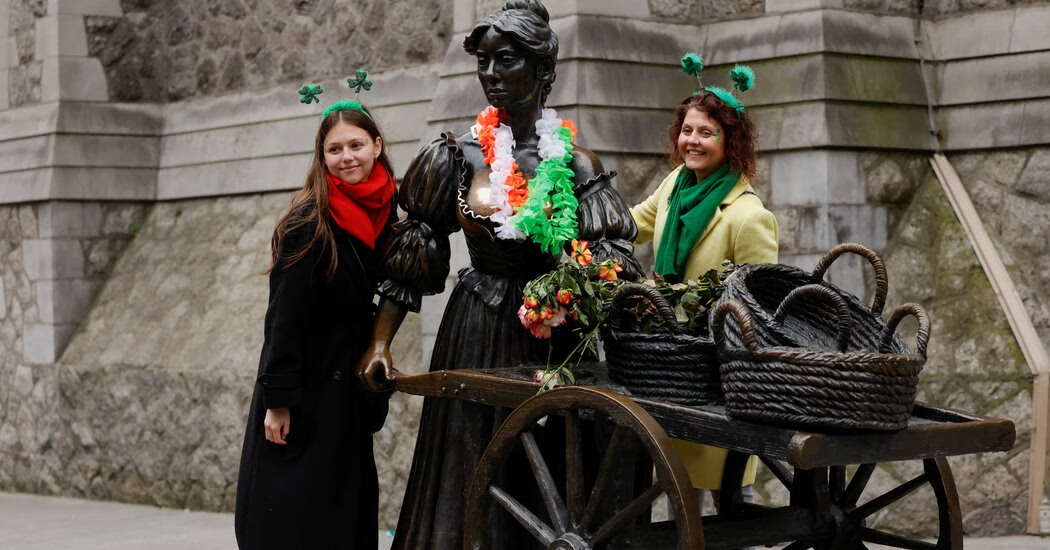In song, and then in bronze, she has become an emblem of Irish culture and an enduring symbol of working-class Dublin.
But to the familiar folklore of Molly Malone represented in her statue on Suffolk Street in central Dublin — a pretty young face, a hawker’s cart of cockles and mussels, a low-cut frilly dress — a new element will soon be added: wardens, provided by Dublin City Council.
The life-size statue was erected to commemorate the central figure of “Molly Malone” or “Cockles and Mussels,” a song belted out during St. Patrick’s Day celebrations around the world. The City Council said on Thursday that it was responding to complaints about people, especially tourists, touching the statue.
More specifically, the problem is with visitors grabbing and rubbing the statue’s breasts, supposedly for luck — something they do so often that its bust has become discolored.
The stewards will be positioned next to the statue for a week in May, and will not only guard it, but also try to educate tourists about it, the council said in a statement. The city will also repair the damage to the statue’s bust, a process that it has had to repeat over the years.
It is responding in part to a “Leave Molly mAlone” campaign led by Tilly Cripwell, 23, a final-year student at Trinity College Dublin who is also a regular busker on Suffolk Street.
On Thursday, she welcomed the restoration work as a step toward rectifying the “physical and symbolic damage,” but was less impressed by the idea of wardens.
“The stewarding system feels like a figurative barrier, which defeats the point, and the point is mind-set reform around behavior toward the statue,” she said.
People coming to see Molly Malone help make Suffolk Street a lucrative busking spot. Singing there, Ms. Cripwell said, she could collect at least 60 euros an hour, about $66. But she grew ever more infuriated at seeing tourists and nighttime drinkers grope the statue.
While touching parts of statues for luck is a widespread tradition — the toes of St. Peter in the Vatican, the groin of the 19th-century journalist Victor Noir in Paris’s Père Lachaise cemetery, even the testicles of Wall Street’s “Charging Bull” — the treatment of one of Dublin’s few statues of women struck Ms. Cripwell as both crude and sexist.
“I just got more and more triggered by it, and one day I just thought if I want to keep on busking by the statue, I’m going to have to do something about this,” she said.
To protest, Ms. Cripwell has used an alternative version of the popular folk song. “If she was there beside you, if she was alive oh,” she sang during one of her demonstrations, which have been joined by other performers. “Crying, ‘Stop, that’s enough’ — so leave Molly alone.”
In the song, which has been mournfully covered by Joni Mitchell and Sinead O’Connor, Molly Malone is a tragic figure, a fishmonger who sells her wares on Dublin’s streets and eventually dies of a fever. People have long debated whether the song is based on a real person.
The statue, commissioned in 1988 as part of celebrations of Dublin’s 1,000th anniversary, solidifies one particular version of the story, according to research by Sean Murphy, a city historian.
The authorities planning the celebration suggested that they had identified the real Molly, pointing to the baptism and burial records of a woman named Mary Mallone, who was christened in 1663 and buried in 1699 near the site chosen for the statue. Mr. Murphy regards that as far from sufficient proof: The name was a common one, he said, and documentary evidence of the song begins well over a century later.
“Myself and others protested back in the 1980s about the statue but were ignored,” he said.
The design of the statue, and the publicity surrounding it, may have encouraged undignified treatment, he added. He said the sculpture represented Molly Malone as “a prosperous trader who freelanced as a prostitute,” something that the historian calls “a gratuitous charge.”
Ms. Cripwell is seeking to give the disputed history a new chapter. Her campaign has sought to have the statue placed on a raised plinth, as many of Dublin’s heroic statues of men are, although the city’s statement dismissed that option as “costly.”
And in place of stewards explaining the statue, Ms. Cripwell says she would prefer a plaque.
“People don’t know the story — whether it’s fictional, whether it’s real, they don’t know it,” she said.
Source: https://www.nytimes.com/2025/04/04/world/europe/dublin-molly-malone-statue.html





